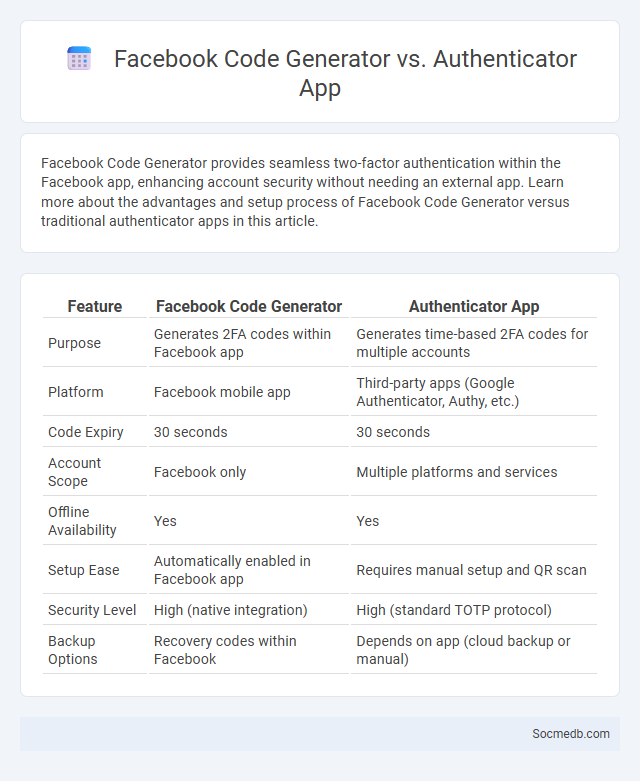
Photo illustration: Facebook Code Generator vs Authenticator App
Facebook Code Generator provides seamless two-factor authentication within the Facebook app, enhancing account security without needing an external app. Learn more about the advantages and setup process of Facebook Code Generator versus traditional authenticator apps in this article.
Table of Comparison
| Feature | Facebook Code Generator | Authenticator App |
|---|---|---|
| Purpose | Generates 2FA codes within Facebook app | Generates time-based 2FA codes for multiple accounts |
| Platform | Facebook mobile app | Third-party apps (Google Authenticator, Authy, etc.) |
| Code Expiry | 30 seconds | 30 seconds |
| Account Scope | Facebook only | Multiple platforms and services |
| Offline Availability | Yes | Yes |
| Setup Ease | Automatically enabled in Facebook app | Requires manual setup and QR scan |
| Security Level | High (native integration) | High (standard TOTP protocol) |
| Backup Options | Recovery codes within Facebook | Depends on app (cloud backup or manual) |
Introduction to Facebook Code Generator, Authenticator App, and Two-Factor Authentication
Facebook Code Generator provides a secure way to access your account by generating login codes directly within the Facebook app, enhancing protection against unauthorized access. Authenticator apps like Google Authenticator or Authy create time-based one-time passwords (TOTPs) that serve as a second layer of security for your social media accounts. Enabling Two-Factor Authentication (2FA) significantly reduces the risk of account breaches by requiring both your password and a unique verification code, ensuring your Facebook account stays safe from hackers.
Understanding Facebook Code Generator
Facebook Code Generator enhances your account security by providing temporary, unique login codes through the Facebook app. This two-factor authentication method requires you to enter a generated code along with your password, reducing the risk of unauthorized access. Using Code Generator ensures your social media presence remains protected from phishing and hacking attempts.
What is an Authenticator App?
An authenticator app is a security tool generating time-based one-time passwords (TOTPs) for two-factor authentication (2FA), enhancing account protection by requiring both a password and a dynamic code. Widely used on social media platforms like Facebook, Instagram, and Twitter, the app significantly reduces the risk of unauthorized access and phishing attacks. Popular authenticator apps include Google Authenticator, Microsoft Authenticator, and Authy, each supporting multi-platform synchronization and offline code generation.
Explaining Two-Factor Authentication (2FA)
Two-Factor Authentication (2FA) enhances social media account security by requiring users to provide two forms of verification: something they know (password) and something they have (a temporary code sent to a mobile device or generated by an authenticator app). This additional security layer significantly reduces the risk of unauthorized access, even if passwords are compromised. Platforms like Facebook, Twitter, and Instagram support 2FA methods such as SMS codes, authenticator apps, and hardware tokens to protect user data and privacy.
Key Differences Between Code Generator and Authenticator Apps
Code generator apps create temporary, time-based one-time passwords (TOTPs) for two-factor authentication, enhancing security by requiring a unique code during login. Authenticator apps store and manage multiple accounts, generating TOTPs without needing an internet connection, improving convenience and security across platforms. Unlike code generators that solely produce codes, authenticators integrate with various services, supporting QR code scanning and backup options for seamless account recovery.
Security Comparison: Which Method is Safer?
End-to-end encryption (E2EE) offers superior security for social media communications by ensuring only the communicating users can read the messages, preventing intermediary access. Two-factor authentication (2FA) adds an extra verification layer to user accounts, reducing unauthorized access risks but does not encrypt message content. Compared to traditional password-only protection, E2EE combined with 2FA provides the most robust defense against cyber threats on social media platforms.
User Experience: Ease of Use and Accessibility
Social media platforms prioritize user experience by designing intuitive interfaces that simplify navigation and content discovery, enhancing ease of use for all demographics. Accessibility features such as screen readers, voice commands, and customizable text sizes ensure inclusivity for users with disabilities. These optimizations drive higher engagement and user satisfaction, reinforcing the platforms' global reach and usability.
Compatibility with Different Devices and Platforms
Social media platforms are designed to be compatible with a wide range of devices, including smartphones, tablets, and desktops, ensuring seamless access and interaction across iOS, Android, and web browsers. Your experience remains consistent and optimized whether you use apps, mobile browsers, or desktop versions, supporting features like responsive design and cross-platform synchronization. Accessibility and device compatibility are key to maximizing engagement and connectivity on social media.
Pros and Cons of Each Authentication Method
Social media authentication methods vary widely, with OAuth offering seamless third-party logins that enhance user convenience but may pose privacy risks if permissions are misused. Multi-factor authentication (MFA) significantly boosts account security by combining passwords with additional verification steps, though it can sometimes inconvenience users due to extra time and device requirements. Biometric authentication provides quick and robust access tied to unique physical traits but raises concerns over data breaches and the irreversibility of compromised biometric data; understanding these pros and cons helps you select the most suitable method for your social media security needs.
Choosing the Best 2FA Option for Facebook Security
Selecting the best two-factor authentication (2FA) option for Facebook security enhances account protection against unauthorized access by requiring an additional verification step beyond the password. Facebook supports various 2FA methods, including authentication apps like Google Authenticator, security keys such as YubiKey, and SMS codes, with authentication apps generally offering higher security than SMS. Using hardware-based security keys or app-based authenticators significantly reduces the risk of phishing attacks and account breaches compared to relying solely on text message verification.
 socmedb.com
socmedb.com